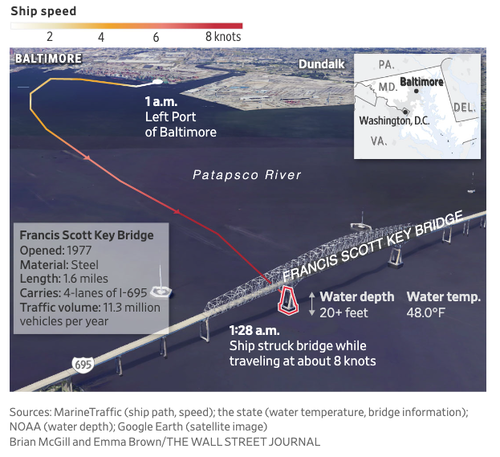
Catastrophic supply chain snarls are materializing in the Mid-Atlantic area after a container ship rammed a 1.6-mile-long bridge at the Port of Baltimore, causing the bridge to collapse and paralyzing terminals along the port.
Before we shed more color on the worsening supply chain issues, a new Wall Street Journal report cites people familiar with the investigation into the crash as saying contaminated fuel could've contributed to the container ship "Dali" losing power.
According to a Coast Guard briefing report viewed by the WSJ, Dali's lights began to flicker about an hour after the ship began steaming down the marine channel out of the Baltimore Inner Harbor.
Breakdown of the multiple power failures on the container ship 'Dali' that likely caused the impact with the Francis Scott Key Bridge in Baltimore today.
— Massimo (@Rainmaker1973) March 26, 2024
[🎞️ Moshe Schwartz]pic.twitter.com/ST5iBXrjxF
"The vessel went dead, no steering power and no electronics," said an officer aboard the ship.
"One of the engines coughed and then stopped. The smell of burned fuel was everywhere in the engine room, and it was pitch black," the officer said, adding that the vessel didn't have time to drop anchors before hitting the bridge. Minutes before the crash, officers on the ship issued a mayday call to the Coast Guard.

Fotis Pagoulatos, a naval architect in Athens, said contaminated fuel could seize up the ship's main power generators and result in a complete blackout and loss of propulsion.
During a press conference, Jennifer Homendy, chair of the National Transportation Safety Board, said an investigation is underway to review the vessel's operations and safety logs and black box recorders to determine what happened in the moments leading up to Baltimore's biggest industrial disaster in several generations.
REPORT: There were no vehicles traveling on the Francis Scott Key Bridge when it fell into the ocean thanks to heroic police officers who jumped into action.
— Collin Rugg (@CollinRugg) March 26, 2024
It has now been confirmed that the only people on the bridge when it collapsed was a pothole repair crew.
A total of… pic.twitter.com/U6PZPO8SDG
Hours after the incident, the White House and federal government agencies quickly ruled out a cyber attack or industrial sabotage as the source of the ship's power loss. With an investigation barely underway, it would seem too preliminary to rule out those things. It's not yet illegal to have an open mind.
Despite legacy media outlets won't even entertain the slightest possibility of a cyber attack or industrial sabotage, some X users say they aren't ruling anything out, considering NATO and Russia are on the brink of a major conflict, the Red Sea crisis continues, Hamas-Irasel war rages on, and Sino-US relations have yet to recover fully.
We know that in a matter of seconds, the Dali and its all-Indian crew that rammed the bridge triggered an instant shutdown of the Port of Baltimore that could take weeks, if not months, to restore.
"This is a shut down of a major port, and rebuilding will take a significant amount of time as it is over water," Nada Sanders, a professor of supply-chain management at Northeastern University, told the WSJ in a separate note.
Sanders said, "We will see the effects domestically and globally in terms of shortages and higher prices for the average consumer."
Bloomberg Economic Insights shows that the auto, energy, and food industries will be the most affected. Here's an explanation of the disruption:
- The wreckage from the Francis Scott Key Bridge essentially blocks incoming and outgoing traffic to the Port of Baltimore.
- According to the Bureau of Transportation Statistics, the port ranked 17th in terms of total tonnage handled in 2021. We estimate it intermediates about 2%-3% of US imports.
- By those metrics, the disruption to Port of Baltimore traffic would appear to have minimal impact on the broader US economy. But that most likely understates the full effect.
According to S&P Global Market Intelligence, the Port of Baltimore handled about 3% of all East Coast and Gulf Coast imports in the year through Jan. 31. It's a crucial terminal for European carmakers such as Mercedes-Benz Group AG, Volkswagen AG, and BMW.
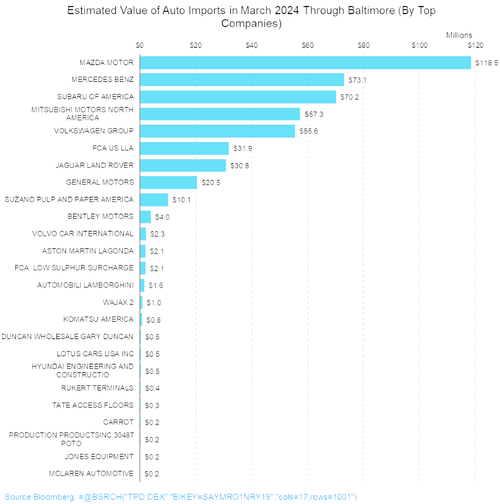
It's also the second-largest terminal for US coal exports, with a shutdown likely crimping shipments to India. And many more terminals will be shuttered...
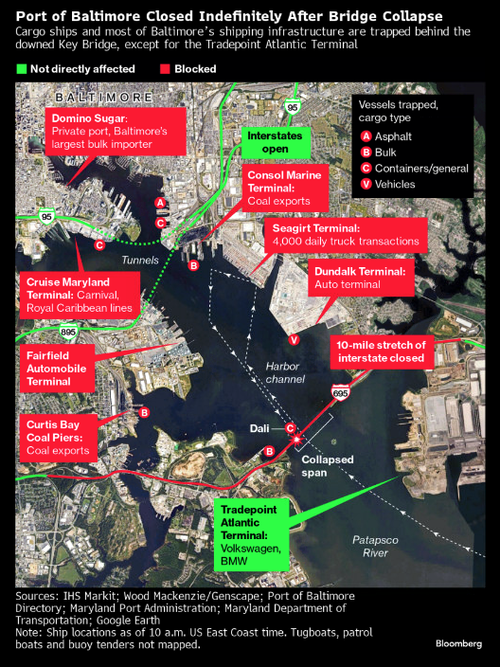
The 984-foot ship was hauling containers of Chinese-made furniture, appliances, plasticware, and construction machinery.
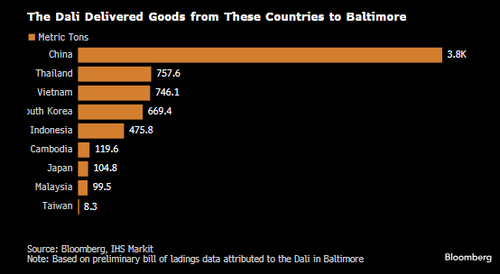
Expect a localized shortage of these products?
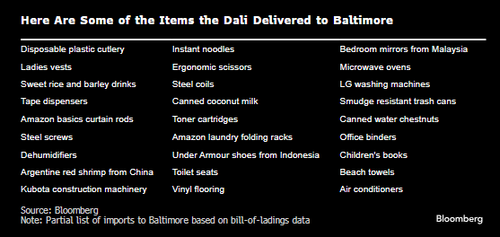
US Customs and Border Protection provides a view into Dali's cargo.
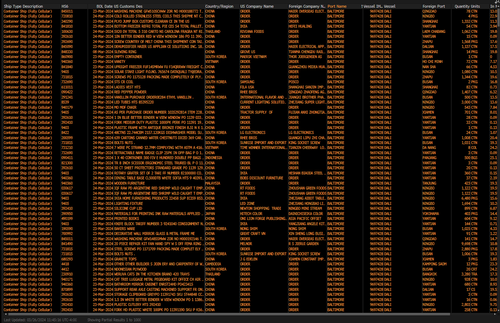
Why didn't the State of Maryland or Baltimore City install protective barriers against ship strikes on the Key Bridge? Were woke Democrats in Annapolis too concerned about DEI and burning the state into the ground with reckless spending than care about infrastructure? Yet another failure by Democrats who are asleep at the wheel.
Catastrophic supply chain snarls are materializing in the Mid-Atlantic area after a container ship rammed a 1.6-mile-long bridge at the Port of Baltimore, causing the bridge to collapse and paralyzing terminals along the port.
Before we shed more color on the worsening supply chain issues, a new Wall Street Journal report cites people familiar with the investigation into the crash as saying contaminated fuel could’ve contributed to the container ship “Dali” losing power.
According to a Coast Guard briefing report viewed by the WSJ, Dali’s lights began to flicker about an hour after the ship began steaming down the marine channel out of the Baltimore Inner Harbor.
Breakdown of the multiple power failures on the container ship ‘Dali’ that likely caused the impact with the Francis Scott Key Bridge in Baltimore today.
[🎞️ Moshe Schwartz]pic.twitter.com/ST5iBXrjxF
— Massimo (@Rainmaker1973) March 26, 2024
“The vessel went dead, no steering power and no electronics,” said an officer aboard the ship.
“One of the engines coughed and then stopped. The smell of burned fuel was everywhere in the engine room, and it was pitch black,” the officer said, adding that the vessel didn’t have time to drop anchors before hitting the bridge. Minutes before the crash, officers on the ship issued a mayday call to the Coast Guard.

Fotis Pagoulatos, a naval architect in Athens, said contaminated fuel could seize up the ship’s main power generators and result in a complete blackout and loss of propulsion.
During a press conference, Jennifer Homendy, chair of the National Transportation Safety Board, said an investigation is underway to review the vessel’s operations and safety logs and black box recorders to determine what happened in the moments leading up to Baltimore’s biggest industrial disaster in several generations.
REPORT: There were no vehicles traveling on the Francis Scott Key Bridge when it fell into the ocean thanks to heroic police officers who jumped into action.
It has now been confirmed that the only people on the bridge when it collapsed was a pothole repair crew.
A total of… pic.twitter.com/U6PZPO8SDG
— Collin Rugg (@CollinRugg) March 26, 2024
Hours after the incident, the White House and federal government agencies quickly ruled out a cyber attack or industrial sabotage as the source of the ship’s power loss. With an investigation barely underway, it would seem too preliminary to rule out those things. It’s not yet illegal to have an open mind.
Despite legacy media outlets won’t even entertain the slightest possibility of a cyber attack or industrial sabotage, some X users say they aren’t ruling anything out, considering NATO and Russia are on the brink of a major conflict, the Red Sea crisis continues, Hamas-Irasel war rages on, and Sino-US relations have yet to recover fully.
We know that in a matter of seconds, the Dali and its all-Indian crew that rammed the bridge triggered an instant shutdown of the Port of Baltimore that could take weeks, if not months, to restore.
“This is a shut down of a major port, and rebuilding will take a significant amount of time as it is over water,” Nada Sanders, a professor of supply-chain management at Northeastern University, told the WSJ in a separate note.
Sanders said, “We will see the effects domestically and globally in terms of shortages and higher prices for the average consumer.”
Bloomberg Economic Insights shows that the auto, energy, and food industries will be the most affected. Here’s an explanation of the disruption:
- The wreckage from the Francis Scott Key Bridge essentially blocks incoming and outgoing traffic to the Port of Baltimore.
- According to the Bureau of Transportation Statistics, the port ranked 17th in terms of total tonnage handled in 2021. We estimate it intermediates about 2%-3% of US imports.
- By those metrics, the disruption to Port of Baltimore traffic would appear to have minimal impact on the broader US economy. But that most likely understates the full effect.
According to S&P Global Market Intelligence, the Port of Baltimore handled about 3% of all East Coast and Gulf Coast imports in the year through Jan. 31. It’s a crucial terminal for European carmakers such as Mercedes-Benz Group AG, Volkswagen AG, and BMW.

It’s also the second-largest terminal for US coal exports, with a shutdown likely crimping shipments to India. And many more terminals will be shuttered…

The 984-foot ship was hauling containers of Chinese-made furniture, appliances, plasticware, and construction machinery.

Expect a localized shortage of these products?

US Customs and Border Protection provides a view into Dali’s cargo.

Why didn’t the State of Maryland or Baltimore City install protective barriers against ship strikes on the Key Bridge? Were woke Democrats in Annapolis too concerned about DEI and burning the state into the ground with reckless spending than care about infrastructure? Yet another failure by Democrats who are asleep at the wheel.
Loading…





